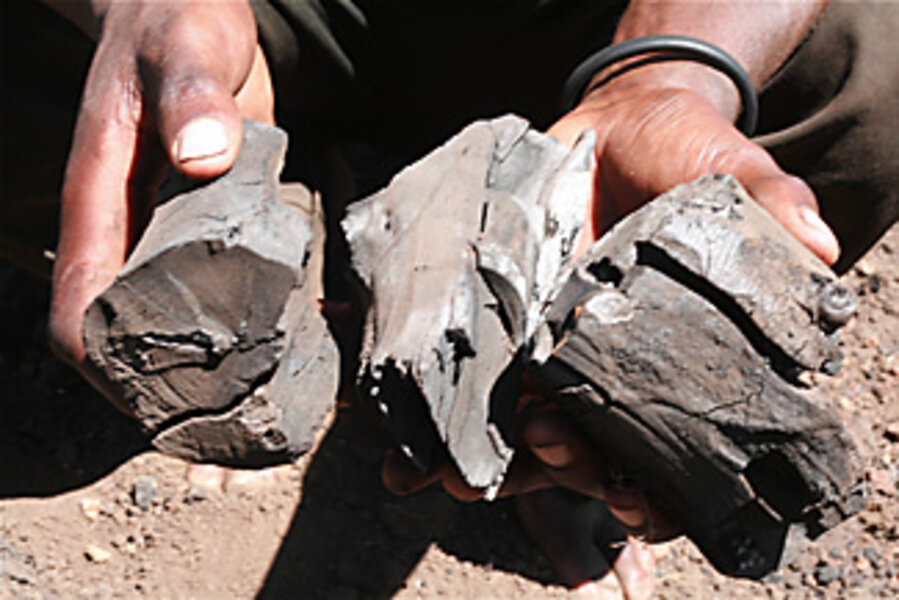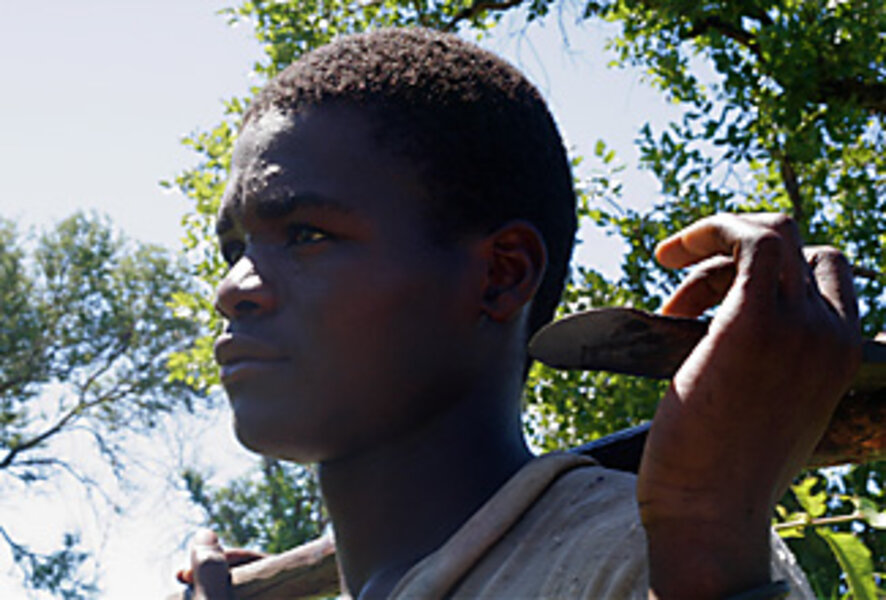Charcoal fuels the economy and deforestation of Mozambique
Loading...
| Matenga, Mozambique
Santos Junior Guilaza's hands are calloused, burned countless times by the smoldering wood he separates, barehanded, from the dark, steaming dirt of his earthen kiln. His bare feet are leathery and flattened from trekking over this overgrown land – from his bamboo-and-thatch hut, past increasingly rare trees, and to the road where he, like thousands upon thousands of others, sells the charcoal that fuels southern Africa.
"I go by foot," he says matter-of-factly as he guides a visitor through shoulder-high grasses that can slice skin like fine razors. ("Watch for the snakes," he warns.)
Mr. Guilaza has been chopping trees and making charcoal for as long as he can remember. It's what his father did and his grandfather, too. It's what all the men do in this village, not far from the crocodile-thick Pungue River. And it's how legions of impoverished people throughout the developing world stay alive.
Charcoal is more portable than simple wood, and can be made with trees, earth, fire – and sweat. In regions where electricity and money are scarce, but physical toil is not, the fuel is everywhere. In Mozambique, for instance, the government estimates that charcoal is the main fuel source for 80 percent of the population.
This causes intense international hand-wringing. It has given purpose to dozens of nongovernmental organizations (NGOs), has prompted countless academic papers, and concerns environmentalists watching the world's trees disappear.
Along with South America, Africa loses forests at a faster rate than almost any place on earth, according to the UN Food and Agriculture Organization. Many farmers use a slash-and-burn process, cutting forest and burning the remaining vegetation to plant crops in the temporarily rich soil. Logging – illegal and legal – clears large amounts of forests. But almost half of Africa's forest loss is a result of people chopping trees for firewood or charcoal, estimates the UN Billion Tree Campaign.
Asked why he makes charcoal, Guilaza reacts like an American might if asked to explain the whys of driving a car: "Everyone does the charcoal." It's the main way, in this cash-scarce region, to get a few meticais to buy a shirt or a goat or a pencil for a child. It's simply a way of life.
But that doesn't mean that Guilaza is unreflective. He gestures to the chaotic collection of grasses, skinny young trees, and thick bushes: "This used to be a no man's land, a forest." But over the past decade, he says, the sky-kissing trees have become fewer and fewer.
Cash-earning work is scarce in rural Mozambique, which is largely a subsistence and barter economy. In some parts of the country, as much as 70 percent of individuals' income is from charcoal, estimates the Stockholm Environment Institute.
So it's no surprise that Guilaza seees no other choice. But he also says he has started planting saplings, because he worries that at the rate the forest around his village is disappearing, there will be nothing left for his children to chop.
"[Charcoal] is probably the biggest problem in Mozambique, as far as deforestation," says Regina Cruz, a Mozambican forestry expert. "Whole forests are being cut. But what else can the people do."
• • •
Today, Guilaza walks to his kiln, a 30-minute walk from his house. There's no set schedule, he says, but when he woke up at 5 a.m., he knew that instead of going to his corn fields with his wife, Donazia, he would come to this pile of exposed earth. He started this oven a few days before, after he'd chopped two thick trees that grew alongside his corn fields.
In this part of Mozambique, the regulo, or regional leader, tells people where they can plant crops and where they can't. Too close to an ancestral cemetery is a no-no, for instance, as is planting on your neighbor's turf. Villagers can cut most trees that grow on and around their fields but not trees protected by traditional law, such as the panga panga or marula.
People also know that stealing another man's timber will end up in a village-wide dispute, Guilaza says. A log in the middle of the brush might look abandoned, but it probably represents half a family's monthly income.
After Guilaza chopped his trees – wood chips flying from his hand-length ax head – he separated the skinnier branches from the 1- to 2-foot thick trunks. He took the smaller wood pieces home for his own family's cooking. (Last week Donazia made a goat curry stew over a wood fire.) The thickest chunks go toward charcoal.
Guilaza sets up the oven by clearing a swath of grass about 30 feet across and turning over the rich ground, just like his father and grandfather once showed him. He piles the remains of the tree in the center, and covers them with dried grass. Then he lights the wood and shovels dirt on top of the pile, leaving a small hole on top to allow just enough oxygen for a slow burn. He'll make a new kiln for the next two or three trees he chops.
The fire will smoulder for a week, he says, the wood gradually transforming into the thick chunks of charcoal. After a few days of burning, he shovels the mixture of dirt and burned wood to a section of the clearing and sifts out the pieces of charcoal. When they're cool enough, he stuffs them into 35 to 40 burlap bags that he buys for a few cents in a neighboring town. After stuffing them full, he adds a grass net at the top that will allow it to hold a bit more. Guilaza says each 100-pound bag sells for 60 meticais, about $2.40.
The charcoal will heat stoves in cities from southern Mozambique to northern Malawi, from Zimbabwe to South Africa.
He sells the charcoal along the main road to travelers at a stand he and a few neighbors share. But sometimes he will pile his bicycle with bags and sell the charcoal in nearby towns, where he can sell the bags for double the price.
In the US, "charcoal" evokes small, evenly-shaped briquettes that fuel summer barbecues. Guilaza's wares are larger and less uniform, more clearly the blackened remains of trees. They also burn longer than the American standard because they come from hardwood, not plantation timber, says Grant Norvall, a Zimbabwean agricultural consultant in Mozambique.
"It's very, very good quality," Mr. Norvall says of the longer- and hotter-burning charcoal. He says that the buyers are not just people from Mozambique's cities who don't have electricity. Wealthier individuals pick up bags of charcoal because it's more economical, or because they just prefer grilling. A common scam, Norvall says, is for long-haul truckers to exchange fuel – paid for by their companies – for bags of charcoal, which they then sell for their own profit in neighboring countries.
• • •
By noon, the combination of heat from Guilaza's kiln and from the blinding Mozambican sun is almost unbearable. This is the time when he rests, leaning a forearm on his ax. He'll walk back to his hut, where his wife has made lunch. He will try to stay in the shade.
Meanwhile, the heat shimmers on top of the pile of earth he made, distorting the green landscape beyond.
Stephanie Hanes's reporting for this article was partially funded by an Alicia Patterson Foundation fellowship.






